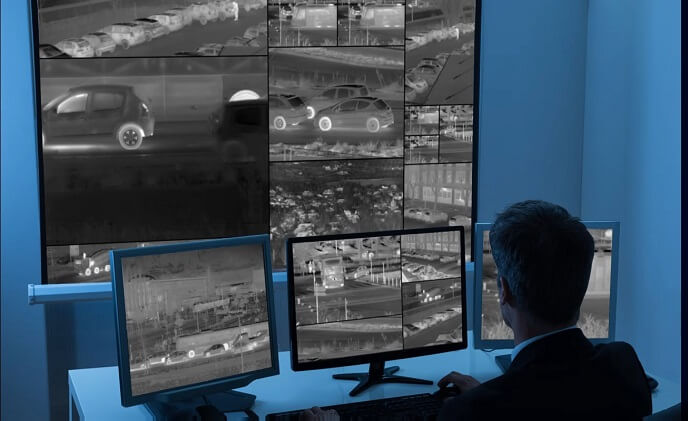Thermal imaging on its own is not a complete solution for traffic management. However, when applied with video analytics, thermal imaging cameras can be very beneficial.
The need for more efficient and effective traffic management systems is increasing as urbanization and population growth continue. The use of thermal imaging as part of a comprehensive traffic management system could provide operators with improved accuracy and efficiency.
Although thermal imaging has a long history in military applications and in perimeter detection for physical security, and its use in traffic management is not yet ubiquitous, the use of thermal sensors across verticals is growing rapidly.
A report from MarketsandMarkets estimates the global thermal imaging market will grow from US$7.7 billion in 2016 to $10.3 billion by 2021, at a CAGR of 5.9 percent. Growth is attributed to the rising demand of thermal cameras as a result of declining prices. Furthermore, growth is also being credited to the
increasing need of thermal cameras in all commercial applications, including transportation.
In fact, the use of thermal imaging in the automotive application segment is expected to gain traction in the next five years, according to the report. “The increasing use of thermal cameras in the automotive sector to reduce the risks in driving, especially during the night, is one of the major reasons for the growth of thermal imaging market in this application,” stated MarketsandMarkets.
 Emmanuel Bercier,
Emmanuel Bercier,
Strategic Marketing Manager,
ULIS
While applying thermal imaging directly to automotive use isn’t the same as using it for traffic management, the need for it in the transportation sector can be inferred. Additionally, with the need for traffic management growing, combining different technologies, including thermal imaging, will only help create more effective solutions.
Thermal imaging on its own is not a complete solution for traffic management. However, when applied with video analytics, thermal imaging cameras can be very beneficial.
“Thermal cameras produce images similar to the standards rendered by visible cameras, especially in terms of the shape of the object. This means that video analytics developed for visible cameras to conduct shape recognition, motion detection, intrusion detection, people counting, etc., can also be applied to thermal image cameras,” said Emmanuel Bercier, Strategic Marketing Manager at ULIS, a France-based manufacturer of thermal imaging sensors. “Moreover, since thermal cameras detect heat from objects, objects are highly distinguishable from their surroundings. As a consequence, this will simplify existing video analytics as it eliminates the need to take light variations or shadow effects into account,” Bercier continued.
Michael Deruytter, Director of Innovation at
FLIR Intelligent Transportation Systems, pointed out that thermal imaging cameras are well suited for video analytics use since the pixels in the image represent heat information — the hotter an object, the more thermal energy is being radiated; however, even extremely cold objects, up to negative 243°C (zero Kelvin), radiate thermal energy.
“Thermal cameras can detect the heat given off by cars, cyclists and pedestrians. This detection information can be used to classify the object or road user and make smart decisions for intersection control in seconds,” Deruytter said. “Intelligent thermal cameras are also used to detect incidents, such as stopped vehicles or wrong-way drivers, which, in turn, speeds up intervention by traffic authorities and emergency services.”
 Thermal cameras allow users to "see" what is happening on the road regardless of weather conditions or time of day.
Thermal cameras allow users to "see" what is happening on the road regardless of weather conditions or time of day.
Source: ULIS
Challenges for Thermal in Traffic
Though thermal cameras do provide better detection,they will mainly be used in conjunction with visible cameras. Combining both camera types will ultimately provide the best detection performance and support identification, for example identifying a license plate number,” Bercier said.
Since both thermal and visible-light technologies have their own unique strengths, combining them makes perfect sense.
 Michael Deruytter,
Michael Deruytter,
Director of Innovation,
FLIR Intelligent Transportation Systems
“This multi-sensor approach has been used in high-end surveillance and border security applications, where a combination of visible and thermal cameras identify and address a wide variety of security threats,” Deruytter explained. “In traffic applications, combining these two camera technologies into one system enables traffic authorities to use the superior detection abilities of thermal cameras while gaining important details with HD visible-light cameras.”
Cost is another factor holding end users and systems integrators back from deploying thermal cameras for traffic management.
“Over the last decade, costs have been greatly reduced. One can now find affordable thermal cameras for traffic management in the range of a few hundred dollars,” Bercier said. He added that thermal cameras now resemble commodity cameras in that they come with standard protocol and interfaces.
“This is positive in making it easier to integrate them in new or existing infrastructures. We are increasingly seeing video management systems integrators consider thermal camera equipment. So infrastructures are almost ready to embed thermal imaging technology,” Bercier added.
Traffic to Bring on the Heat
With the price of thermal continuing to decline and the need for accurate traffic management on the rise, more and more systems will incorporate thermal imaging technology into its solutions. As it was pointed out, thermal imaging by itself is not ideal for traffic management, but as a part of a bigger solutions that utilizes visible-light cameras and video analytics, thermal imaging will bring an extra layer of accuracy and efficiency to traffic management